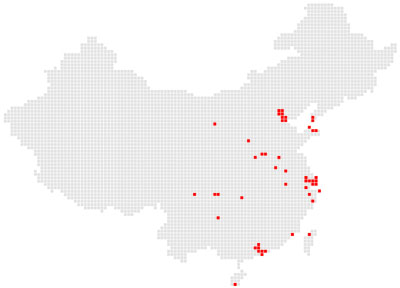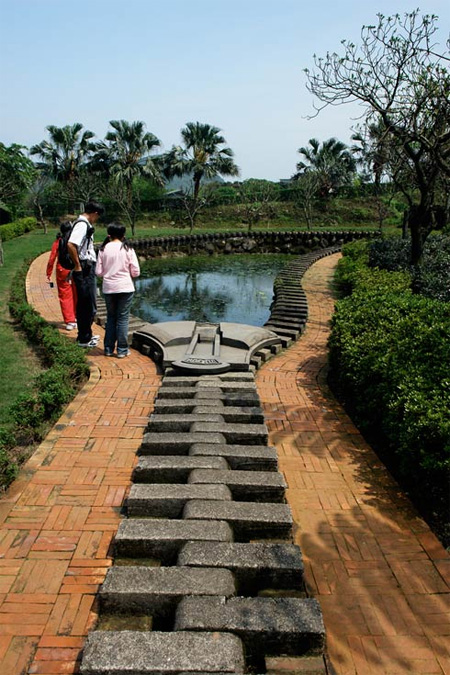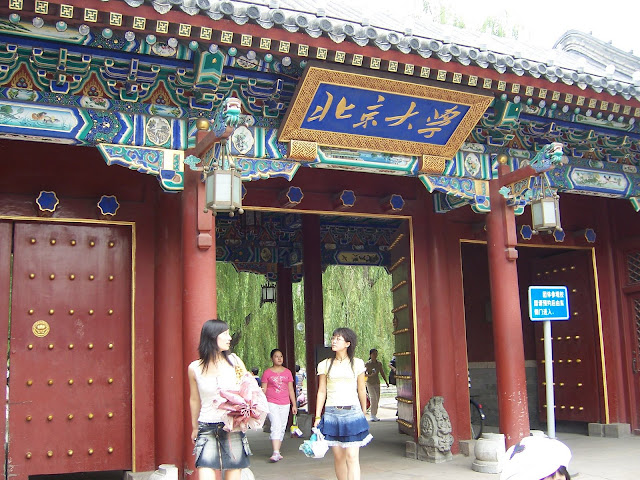 Frank Wright's Fallingwater, Pennsylvania, USA
Frank Wright's Fallingwater, Pennsylvania, USA CAIP Mapping

Thursday, July 30, 2009
CAIP lectured @ Chinese Designers' Region

CAIP co-founder Fei Wang gave a lecture, "Three Heterogeneity Studies of China, between the 18th Century and Contemporary" at Chinese Designers' Region (CDR), London, in June 25th, 2009.
Thanks for William Chen's invitation and nice discussions!
[This is old news. Due to China's Great Fire Wall, blogspot is blocked as always. Sorry for the late update.]
囧 Building in Chongqin
 Someone found out a residential building in Chonging like a face, and very popular Chinese character 囧 (jiǒng).
Someone found out a residential building in Chonging like a face, and very popular Chinese character 囧 (jiǒng).from wikipedia:
"Jiong (Chinese: 囧; variant: 冏; Hanyu Pinyin: jiong3; British Cantonese: Gwing) is a Chinese character meaning a "patterned window" or "as bright as the light peering from outside the window". The character is now rarely used in this sense.
Internet emoticon usage
The character for "Jiong" is nowadays more widely used on the Internet as an ideographic emoticon representing a range of moods, as it resembles a person's face. It is commonly used to express ideas or feelings such as annoyance, shock, embarrassment, awkwardness, scorn or the internet meme "DO NOT WANT".
The use of Jiong as an emoticon can be traced to 2005 or earlier; it was referenced on 20 January 2005 in a Chinese-language article on orz.[1] The character is sometimes used in conjunction with orz, OTZ or its other variants to form "囧rz", representing a person on their hands and knees (Jiong forming the face, while r and z represent arms and legs respectively) and symbolising despair or failure."
Zipper Pond in Taiwan
 Ju Chun, a renowned Taiwanese sculptor, created this breathtaking Zipper Lotus Pond for the Juming Museum, located just outside Taipei, Taiwan.
Ju Chun, a renowned Taiwanese sculptor, created this breathtaking Zipper Lotus Pond for the Juming Museum, located just outside Taipei, Taiwan.Thursday, May 7, 2009
Fake Beida (Beijing University)

Bei Da Xue Yuan High school, Dongguan, Guangdong Province
This is fake Beijing University gate in Dongguan, Guangdong (Canton) Province, which was is a local high school and called the coolest (niu) school gate by bloggers. This school advertises itself in relation with Beijing University and graduates from this school can go to Beijing University directly with exemption of college entry exams. The title of the school is “Bei Da Xue Yuan”, in which there are 3 same characters from Beijing University famous gate, “Bei Jing Da Xue”. Even the calligraphy is totally copied from the Beijing Univ.
 Beijing University, Beijing
Beijing University, Beijing[via 163 and picasa]
Friday, March 27, 2009
How China Sees the World
 This is the cover from The Economist, titled "How China Sees the World," which has similar connotation and technique of Saul Steinberg's early work "How New Yorker Sees the World."
This is the cover from The Economist, titled "How China Sees the World," which has similar connotation and technique of Saul Steinberg's early work "How New Yorker Sees the World."
Friday, February 13, 2009
Wu Liang Ye Headquarter



This is the headquarter of one the most famous Jiu, Chinese alcoholic beverages, Wu Liang Ye, in Yibin, Sichuan Province. All buildings there are very iconic (as bottle, package, company icon, etc), including the gate, factory, administrative buildings, etc.
[via abbs]
Macau Pavilion 2010
Monday, February 9, 2009
OCT East resort, Shenzhen






Another Swiss Interlaken (I have no idea where it is until now) simulacra town in Shenzhen, where there are many theme parks already. Actually, it is the combination of the Western and Eastern. It is very popular for Bourgeois Chinese, who often spend the weekend there.
From the official website: “OCT East resort, a 3.5-billion-yuan (US$0.5 billion) investment supported by OCT group, is located at DaMeiSha, Shenzhen. Occupying about 9 square kilometers, OCT East, the national ecological resort featuring tourism culture, aims at providing visitors with an opportunity to escape from the bustle of city life and return to the nature.
Elaborately designed along the mountain and the sea, OCT East resort has three major theme parks: Knight Valley, Tea Stream Valley and Wind Valley. It has many culture travel functions like ecological tourism, vacation, outdoor sports etc., indicating the harmony relationship between human and the nature.
Phase I of the resort opened on Jul. 28th 2007, offering a vast array of attractions to the public. Tea Stream Valley, a combination of western and eastern cultures, has been constructed based on many fundamental elements such as tea, Buddhism, follower and bamboo etc. Wind Valley features Olympic and golf sports, the Interlaken OCT Hotel, The Interlaken Spa, and the Tea Show. The second phase of the project, Knight Valley, will open in 2008. This park will distinguish itself by forests, rivers and outer space, Red Wine Town and the Statue of Guanyin Sitting in a Lotus Throne.”
[Interlaken is a municipality in the district of Interlaken in the canton of Bern in Switzerland, a well-known tourist destination in the Bernese Oberland.] from Wiki
Lecture @ Cincinnati Art Museum
On January 7, 2009, CAIP co-founder Fei Wang gave the closing lecture for the Cincinnati Art Museum's current exhibition, "China Design Now." His presentation was titled "Three Heterogeneity Studies of China, between the 18th Century and Contemporary."
"China Design Now," organized by the Victoria and Albert Museum, captures an extraordinary moment as China opens up to global influences and responds to the hopes and dreams of its new urban middle class. This is the first exhibition in the United Kingdom and United States to explore the recent explosion of contemporary design in China and the first to attempt to understand the impact of rapid economic development on architecture and design in the country's major cities. From significant architectural projects, including the 2008 Olympic national stadium, to the latest in fashion and graphics the exhibition investigates this dynamic phase.
(Many thanks for Aaron Betsky's generous invitation.)
"China Design Now," organized by the Victoria and Albert Museum, captures an extraordinary moment as China opens up to global influences and responds to the hopes and dreams of its new urban middle class. This is the first exhibition in the United Kingdom and United States to explore the recent explosion of contemporary design in China and the first to attempt to understand the impact of rapid economic development on architecture and design in the country's major cities. From significant architectural projects, including the 2008 Olympic national stadium, to the latest in fashion and graphics the exhibition investigates this dynamic phase.
(Many thanks for Aaron Betsky's generous invitation.)
Subscribe to:
Posts (Atom)




